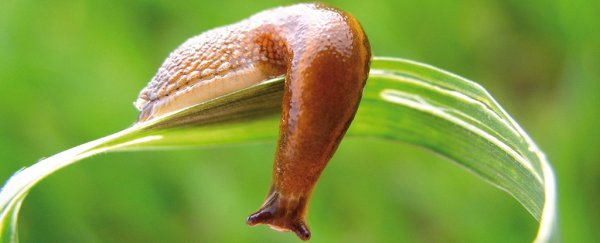Taking inspiration from the mucus secreted by a European slug, researchers have created a new kind of adhesive that could do a better job of sticking together human tissues, even when they're coated in fluid.
The slug-glue not only gets around the problem of binding to wet surfaces, it's both flexible and strong enough to be a promising candidate for repairing some of the body's more industrious components, like the human heart.
Most glues used to hold body bits together have some sort of shortcoming, whether they are potentially toxic in large enough doses, inflexible, or just won't stick to wet surfaces.
A research team led by scientists from Harvard University set out to create a new adhesive, and looked to the dusky arion (Arion subfuscus) for clues.
Usually molluscs such as slugs and snails use their mucus to make sliding across rough terrain a little easier. The dusky arion, like a few other species, is also able to produce another kind of secretion.
This 50 to 70 millimetre (about 2 to 2.7 inch) slug common in parts of Europe and the US defends itself by sticking to nature's often damp surfaces with a mucus that serves as a glue.
The secret behind the mucus's super sticky strength had previously been identified as positively charged proteins in a supportive negatively charged matrix.
Starting with this basic concept, the researchers developed their own mixture of charged proteins in a water-based material called a hydrogel.
The hydrogel holds the proteins in place and helps keep them flexible while they grip onto the surface to be held together.
"The key feature of our material is the combination of a very strong adhesive force and the ability to transfer and dissipate stress, which have historically not been integrated into a single adhesive," says researcher Dave Mooney from Harvard University's Weiss Institute.
The stickiness is the result of three different mechanisms; the positively charged proteins are electrostatically attracted to the slightly negative cells, covalent bonds are then formed between the different molecules, and the proteins physically penetrate the tissue's narrow nooks and crannies.
Unlike other commonly used medical grade glues, such as 'crazy glue'-like cyanoacrylates, this new material takes a little longer to reach maximum strength, which could allow for delicate repositioning during surgery.
There is more to a good glue than just sticking power, though.
"Most prior material designs have focused only on the interface between the tissue and the adhesive. Our adhesive is able to dissipate energy through its matrix layer, which enables it to deform much more before it breaks," says lead researcher Jianyu Li, who currently works at McGill University.
The hydrogel is peppered with calcium ions that form slightly less robust ionic bonds with the gel's matrix.
When stress is applied to the material, these bonds absorb the force and break first, allowing the glue to absorb as much as three times more energy as it flexes, compared to other medical-grade adhesives.
To put their glue through its paces, the researchers applied to a variety of wet and dry organic materials from a pig, including skin, liver, cartilage, and blood-coated heart muscle. The results showed it once again did a far better job than other surgical adhesives.
On the heart, the glue stayed intact even after it was pumped a few tens of thousands of times.
This combination of strength, flexibility, and non-toxicity means the adhesive could have a range of applications.
"We can make these adhesives out of biodegradable materials, so they decompose once they've served their purpose. We could even combine this technology with soft robotics to make sticky robots, or with pharmaceuticals to make a new vehicle for drug delivery," says researcher Adam Celiz, who is currently at Imperial College London.
Further testing is still required, so we won't expect to see any wounds being plugged up with this synthetic slug-slime soon.
It does make you wonder what other solutions are lurking under the tails of some of nature's stickier creatures.
This research was published in Science.
